The Caro Michigan Dam and the surrounding landscape is what one might call “Caro’s Energy Alley”—or “Caro’s Heart”—it is the place in the past and today where raw energy and power have been received and generated, refined, stored, and distributed.
The Oxbow in the Cass River
Early on, the Caro Dam location was traditionally called the “Dam at the Oxbow.”
An Oxbow is a “U” shaped bend in a river.
The Oxbow in the Cass River lies at a commanding location developed in the landscape as a powerful meander or sways in the river.
Today, two power plants have grown from this locale: Just to the northwest is Poet Refinery which is an ethanol-based bio-refinery, and to the northeast is Michigan Sugar Company, which is a sugar-beet refinery.
Both businesses enhance different raw energy types and grew from the fundamental nature and character of the local landscape around the Oxbow in the Cass River.
Both businesses sprang from the natural resources and power that the Oxbow provided.
The Indian fields Indigenous Village
The energy-generating capability of the Oxbow and its surrounding land and water route is seen in the history of the Oxbow.
An early Native American chief, the last in Tuscola County and along the Cass River, was Mark Joshua or Chief Mash-Kee-Yosh, who was born at the Oxbow in 1803.
The site was ancient and even today is a seat of political power!
The Oxbow was the site of an Indigenous village and community!
The local name “Indian Fields” grew from the productivity of food in the land at the Oxbow and the surrounding area.
The Indian Fields Village had great farming potential.
The “Old Cass River Flats” also was near and at the Oxbow and were where Indigenous people planted and harvested corn, potatoes, beans, squash, and “Pinkins” or pumpkins.
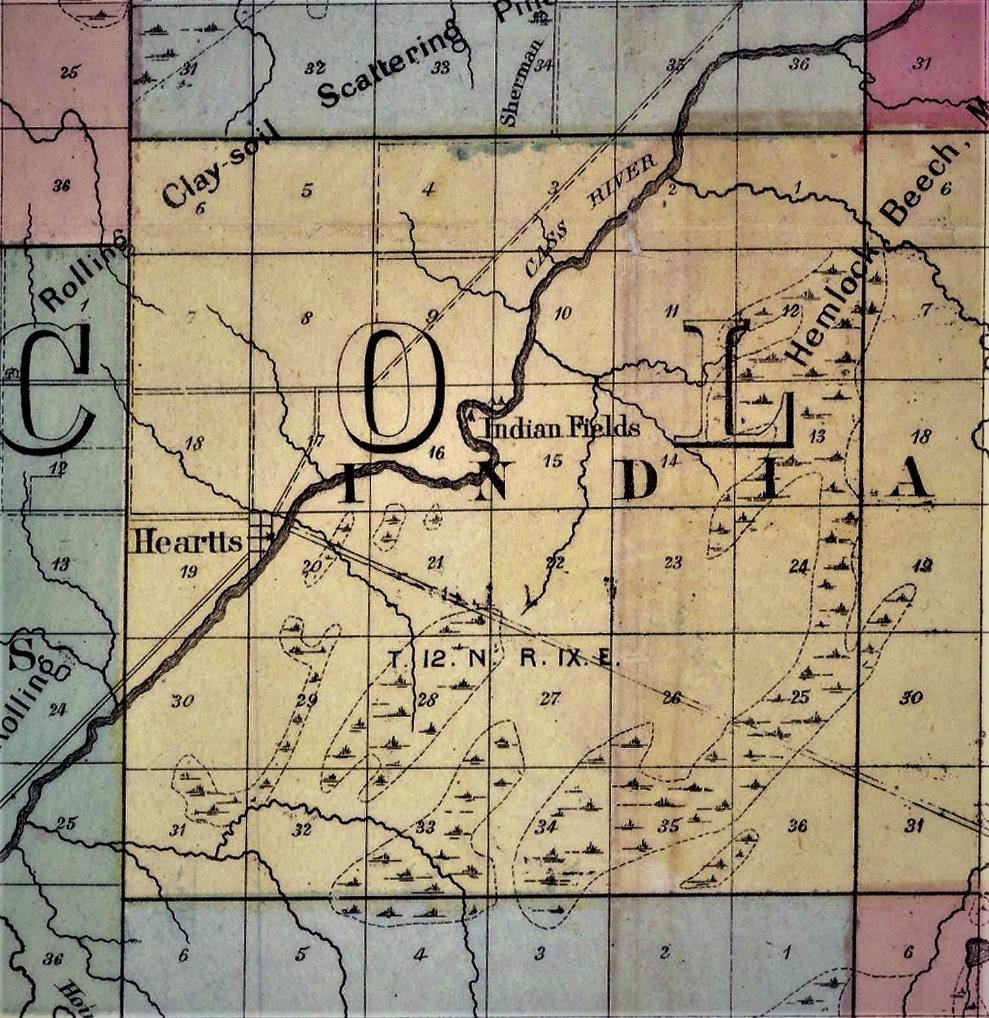
Over centuries, the land surrounding the Oxbow supplied energy and power that was natural and used as a source of nutrition, habitation, transportation, and illumination and was, in general, a place of energy production.
The land around the Oxbow was high compared to the river.
Indigenous people called this highland, particularly above the today’s City of Caro, “Ishpadina.”
In English, high bank or the ridge is the meaning of the Anishinabek word, “ishpadina.”
The local early Indian settlement was nurtured by the potential of the Ox Bow.
Here people were able to store surplus energy from the sky, land, and water through their harvest.
The productivity and energy of the area exceeded the yield of many other locales in the Thumb of Michigan.
Indian corn and other foods were major resources of power or energy storage.
Having Indian corn, squash, and beans made you powerful nutritionally, physically, and politically.
Life at the Indian fields was at its best!
The Dugout Canoe or Tchimanen
The dugout, or “tchimanen,” was built here and along the Cass River and was another great creation of power.
The tschimanen was built from local cork pine that was light and floated high in the water.
The tschimanen was a product of the local environment that nature produced from the elements of the sky or sunlight energy, land, and water that allowed for easy and economical transportation.
The Oxbow Sparked Logging
In 1848, the Oxbow was equally the site of lumberman Curtis Emerson’s camp that ignited the boom on Cass River in logging.
It seemed at times that everything in the northeastern part of the Thumb of Michigan focused and centered on the Oxbow in the Cass River.
Also, it was Emerson’s Camp that restarted the bang, or boom, in the Saginaw Valley logging industry.
The Site of the City of Caro
Near the Oxbow, forming a village was easy.
Many Indian paths or trails intersected each other and crossed at the Oxbow.
The Oxbow at Ishpadina also had the greatest potential as a site for a dam.
The City of Caro grew from the Oxbow and its energy creating or breeding nature.
The high banks or ridges along the river served as walls for a dam.
Major benefits came from controlling the land and the river’s power and energy.
The Caro Electric Light Works
By the early 1900s, power lines ran electrical energy generated by the resources of the Oxbow to the uptown of the City of Caro.
In the early 1890s, the Caro Electric Light Works company was established in Caro.
It was influenced by the work of many people including Thomas Edison.
Caro Electric Light Works was managed and promoted by Joseph H. Harris and owned by Frank Miller who also built the Farmer’s Cooperative Elevator that was located just below Caro near the Oxbow in the Cass River.
By 1892, Caro Electric Light Works was producing electrical energy from a steam engine dynamo.
It supplied electricity for 14 arc lights and 40 incandescent lights in Caro.
Arc lights were used outdoors while incandescent lights were used indoors.
The Caro Light & Power Company
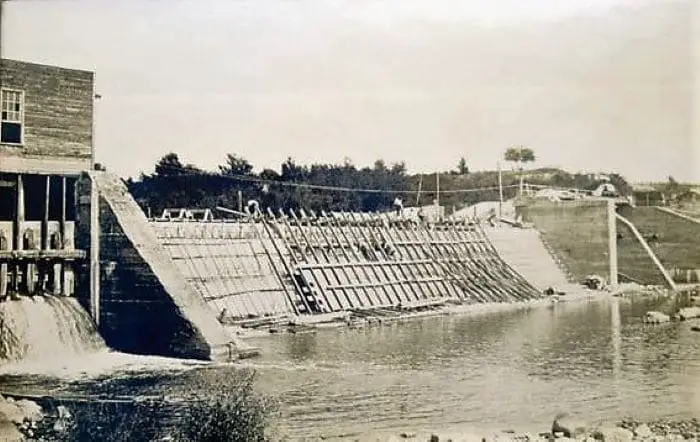
In 1898, Caro Electric Light Works was incorporated under the title of Caro Light & Power Company.
Its owners then were Charles Montague, Joseph Harris, Julian Wilsey, Frederick Wheat, and George Watson.
Caro Light & Power Company at this time operated the Old Steam Plant, the steam dynamo, that was near the elevator and a short distance from the Oxbow.
In 1902, the company was driven to build a dam at the Oxbow just two miles below the downtown of Caro.
The initial building of the dam though met with a major setback.
The foundation was originally built on hardpan instead of bedrock, which made it unstable.
That year’s persistent rain penetrated the hardpan, and the work of the whole summer was gone.
A bedrock foundation, however, was in the end established.
The Caro Michigan Dam Begins Operation
Late, in 1902, for the first time, power was turned on in Caro from a dam.
The gates were closed to hold the water back.
Within a few days, the head at the dam was five to six feet.
The big water wheels at the dam were started.
Electricity was generated and sent over wire lines to Caro.
The arc Lights in Caro were turned on for the first time with power from the Oxbow.
Everything worked wonderfully.
Financial Ruin for the Caro Dam Creator
The cost of the Caro Michigan dam with power equipment and fixtures was $20,000.
In 1903, the assets of Charles Montague went deep into a plunge.
He went into debt and then bankruptcy.
The Caro Light & Power Company was placed under the direction of the Old National Bank of Detroit, and Robert Montague was designated as the local manager.
In 1905, the dam head was reported to be 16 feet.
The dam likewise produced the 20-acre Caro Lake.
In addition to using electricity from the dam, to use Caro Lake, the reservoir, as a source of water, Peninsula Sugar Company is located above the Dam on the north bank of the Cass River.
It took advantage of the nearby abundant electricity and the water to refine sugar beets that were brought in from the northern fields.
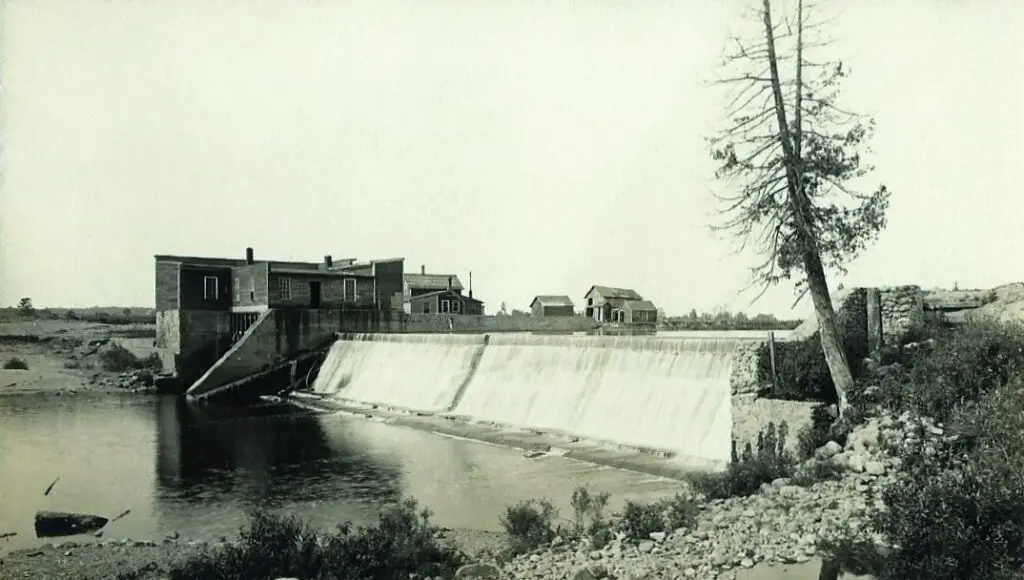
In 1910, Caro Light & Power Company was acquired by Doctors J. M. Ealy and R. M. Olin.
A year later, it was purchased by Hon. Theron W. Atwood made substantial repairs to the dam.
The overhaul amounted to rebuilding the entire dam.
In 1917, the repairs were yet in progress when Atwood died.
The business by his heirs then was up for sale.
The President of the Board of Commerce—Fred C. Striffler—devoted much time and effort to gain outside interests to invest in the dam.
The Consumer’s Power Company & Great Lakes Power Company
November 1, 1922, Consumer’s Power Company acquired the Caro Light & Power Company along with the Caro Michigan dam.
The Consumer’s Power Company also owned numerous dams along the Au Sable River.
The purchase price at Caro was $50,000.
The ownership by Consumer’s Power lasted only until April 1, 1923.
It then sold the dam to Great Lakes Power Company.
The Michigan Electric Power Company
In 1932, the dam was known as the Caro Hydro plant and was operated by the Michigan Electric Power Company which had invested heavily in the dam the previous few years.
Detroit Edison
November 1, 1935, Detroit Edison took ownership and maintained an office in Caro.
The dam then widely became known as the Caro Dam.
The Caro Dam over time, though, was made obsolete and was replaced with other cheaper and more abundant resources for generating electrical energy.
The Dam as the Site of Recreation
Over its history, the Oxbow and the Caro Michigan Dam were grand sites for entertainment and recreation.
In the 1960s the Caro Dam reservoir, or Caro Lake, was a popular site for boating, fishing, and even water skiing.
On the river, many water skiers were towed by motorboats, and their number was complimented often with a greater number of competing fishing boats.
The height of the local Cass River experience was traveling via boat or canoe from a landing near the M-24 Bridge to Caro Lake and the Caro Dam.
It was a tremendous experience to wade and fish just below the Caro Dam.
There the water churned, rumbled, and nearly thundered.
The fish above and below the Caro Dam always seemed to be the largest and the best.
Visiting the Caro Dam was wonderful.
It was a relaxing, tranquil, and serene experience.
The Caro Michigan Dam Today
Today, the Caro Michigan Dam has fallen into languishing and disrepair.
Today, the Caro Dam is held under the private title, and its future is unknown.
The forerunner of the Caro Michigan Dam was the old Oxbow in the Cass River, which was the spark, the startup, the resource of energy that first brought Indigenous and later descendants of European people here to the heart of Tuscola County.
Even today, the locale carries a tremendous drawing power.
Still today, the Oxbow in the Cass River is a resource of recreation and renewal.
The Oxbow generates vast differences in opinions . . . both negative and positive as to whether the old, damaged, the dam should be repaired or removed.
Maybe it should just be left alone.
The Oxbow was a vital resource in the early Indianfields Native Village and Caro community development and existence.
The Cass River, below and above the Oxbow, below and above the Dam, is yet a major and powerful resource in the community!
The Oxbow in the Cass River, the location of the Old Caro Dam, today, still affects, in the end, a great number of people.
Its amazing power still today impacts and influences the lives and the opinion of nearly everyone!
Related Caro Michigan Dam Reading
- Early Public Transportation Of Tuscola County
- Caro Michigan Post Office “Mail On the Farm” Mural
- Brenke Fish Ladder in Lansing Michigan
- Indian Trails of Michigan’s Upper Thumb
- Set Up Your Own Home Wind Turbine
Discover more from Thumbwind
Subscribe to get the latest posts sent to your email.

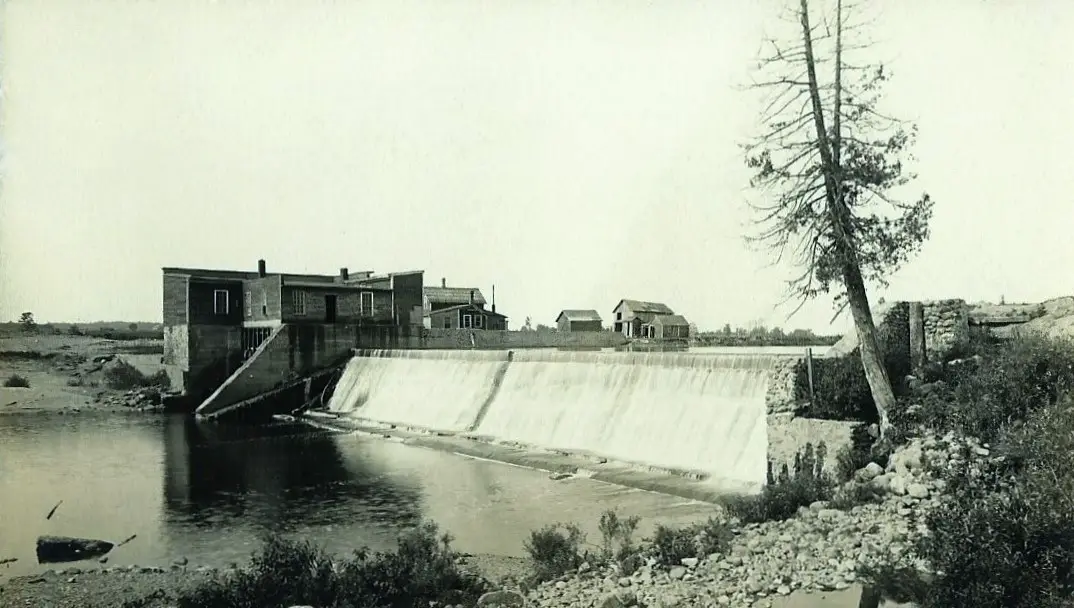

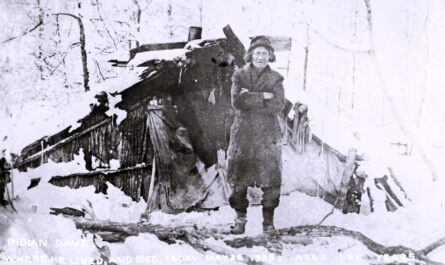
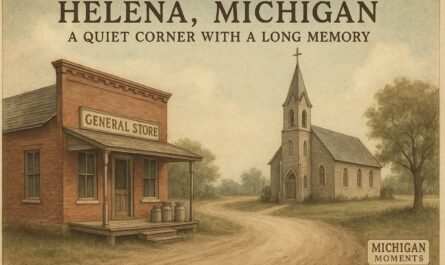
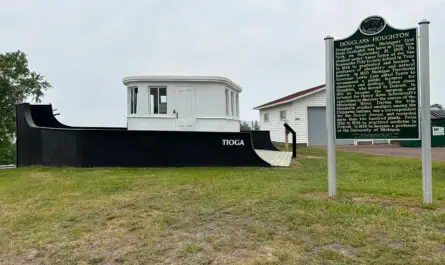
Great read & thanks Mark Putnam I’ve learned a lot about the cool town I grew up in from your articles. I had no idea of the rich history of my hometown of Caro. Thanks again Mark .